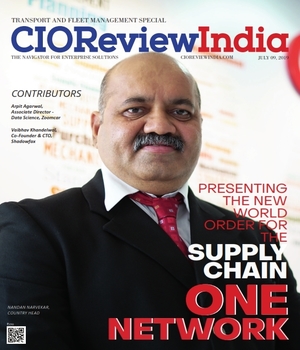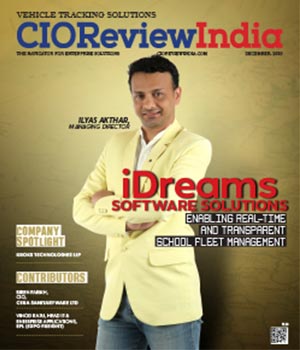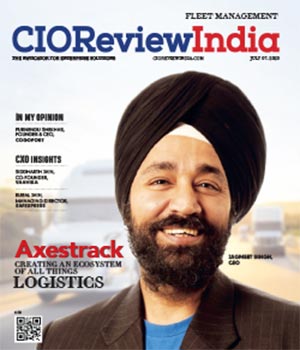
Technology: Building a Competitive Advantage in Logistics
Suheb Siddiqui, Managing Director, PwC | Wednesday, 19 July 2017, 12:33 IST
 In his economic theory magnum opus, Wealth of Nations, Adam Smith says, “Wherever there is great property, there is great inequality.” That advice may be 240 years old, but it is good counsel for today’s logistics providers. The U.S. Commerce department estimates the spending in the U.S. logistics industry to be over $1.33 trillion. With fast changing demands on the industry, logistics providers are making moves to differentiate themselves from competition, create inequality in the marketplace, and gain maximum share of this large market.
In his economic theory magnum opus, Wealth of Nations, Adam Smith says, “Wherever there is great property, there is great inequality.” That advice may be 240 years old, but it is good counsel for today’s logistics providers. The U.S. Commerce department estimates the spending in the U.S. logistics industry to be over $1.33 trillion. With fast changing demands on the industry, logistics providers are making moves to differentiate themselves from competition, create inequality in the marketplace, and gain maximum share of this large market.
Key Issues
In support of these efforts, technology is being leveraged as a potent weapon. As we talk to CEOs, CFOs, CTOs, and CIOs at our logistics clients, a number of developments appear to be at the top of their minds. Here are the key issues in Logistics, based on PwC’s experience and analysis:
1. Customer Expectations: The E-commerce revolution has forever raised customer expectations. Customers have come to expect free and fast shipping as standard. Rightly or not, this has affected the perceived value of logistics in the end consumers’ mind.
2. Transformation in Retail: The demands from the Retail sector have increased significantly - frequent status and shipping updates, constant improvement to systems to serve customers better, and the ability to buy goods online and pick them up in-store. These combine to exert great pressure on logistics providers and their IT departments.
3. Direct to Consumer Models: Manufacturers are beginning to tip-toe towards direct-to-consumer (D2C) business model. They do not want to commit to long term investments in building out their D2C supply chains, leading them to outsource logistics to 3PLs and other providers. They are pushing for faster on/off boarding times thereby creating pressure on IT departments.
4. Industry Consolidation: There has been significant consolidation in the industry as traditional logistics providers seek to combine Truckload, Less Than Truckload, and Last Mile services. According to PwC’s fourth-quarter 2015 analysis of global mergers and acquisitions, transportation and logistics deal size nearly doubled in 2015.
5. New Business Disruptors: A number of new players have entered the logistics sector with disruptive business models. These disruptors have heavily leveraged technology to change the landscape of the logistics sector. Some of these disruptive models include:
a. Mobile / cloud based platform that connects shippers with nearby carriers
b. Web-based, end-to-end freight forwarding with intermodal transit offerings
c. Neighbor-to-Neighbor network of shippers (carpooling for cargo)
d. On-demand service that picks up, packages and ships small items
e. Short and long-distance logistics that includes packaging, documentation and shipping
As a result of these sector issues and challenges, logistics players are responding in interesting ways to establish technology as a competitive weapon.
Upcoming Technology Trends
In such an environment, which technology initiatives can dually lead to a high return on investment while building a strategic advantage? Based on PwC’s experience and analysis, there appear to be three big bets in logistics technology:
1. Core to Cloud: Leading organizations are moving their core applications to cloud.
a. Front office: Over the last few years, PwC has seen a significant uptick in logistics companies launching CRM initiatives. They’re adopting customer facing, cloud based solutions to keep pace with changing customer expectations.
b. Back office: Over the last twelve months, the cloud trend appears to have spread to HCM (Human Capital Management) and ERP (Enterprise Resource Planning) initiatives. CIO’s want to arm their management with a 360 degree view of customers, assets, workforce, and financial performance. And as cloud based ERP and HCM suites mature, logistics providers appear to be adopting them at a much faster pace.
c. Operations: On the rise are initiatives aimed at evaluating TMS (Transportation Management Solutions) and WMS (Warehouse Management Systems) systems, including cloud options. These projects tend to have short payback periods, and with the new versions of these solutions offering multi-tenant and/or cloud architecture, it is becoming a possibility for 3PLs and logistics providers to standardize on technology platforms. Leading logistics providers are building two or three standard platforms specific to an industry, geography, or complexity of their client’s operations instead of implementing the platform for each client.
2. Digital Differentiators: PwC’s 2016 CEO Survey found that 88 percent of global CEOs think that digital technologies deliver “quite high” or “very high” value in operational efficiency gains. With the availability of new age architectures, such as rapid development platforms and integration fabrics, it is finally becoming cost effective to augment vanilla core systems with add edge capabilities that can be competitive differentiators. In addition, data generators like the Internet of Things, and cutting edge analysis tools such as Big Data systems, generating and analyzing information is possible like never before.
3. Driverless Equipment: Emerging technology is creating ripples in the logistics industry. There are exciting developments in the area of driverless equipment in logistics like driverless trucks, semi automatic forklifts and so on. According to a PwC Strategy&’s article, “The Next Autonomous Car Is a Truck”, the use of autonomous long-haul trucks could add up to a multibillion-dollar opportunity for companies throughout the trucking value chain, and in turn, lower prices for consumers.
In the European Truck Platooning Challenge, a recent event organized by the Dutch government, a dozen driverless trucks followed each other using smart technologies to cover all of Europe. A sample of trucks traveled more than 1200 miles and crossed four borders without any human intervention.
As these trends continue to evolve, how is your organization gearing up to take on the new challenges? Are you watching closely before experimenting with these new technologies, embracing them, or placing your bets elsewhere? We would love to hear your thoughts.
CIO Viewpoint
Adoption Of New Technology Trends In The...
By Vinod Raju, Head IT & Enterprise Applications, EFL (Expo Freight)
Vehicle Tracking Bringing Transparency In...
By Biren Parikh, CIO, CERA Sanitaryware Ltd
B2B Integration Key to Supply Chain Excellence
By Dan Sellers, CIO, WSI
CXO Insights
Kroks Technologies LLP Delivering Tracking,...
By Ashith Kunder and Ashwin Kunder, Co-Founders
Technology Pushing Cost Savings in Logistics
By E.R. Williams, Co-Founder & Technology Lead, Zipline Logistics
Technology: Building a Competitive Advantage in...








